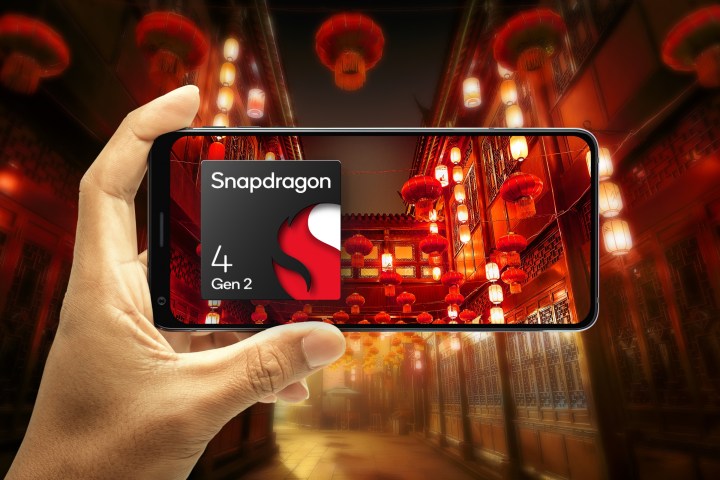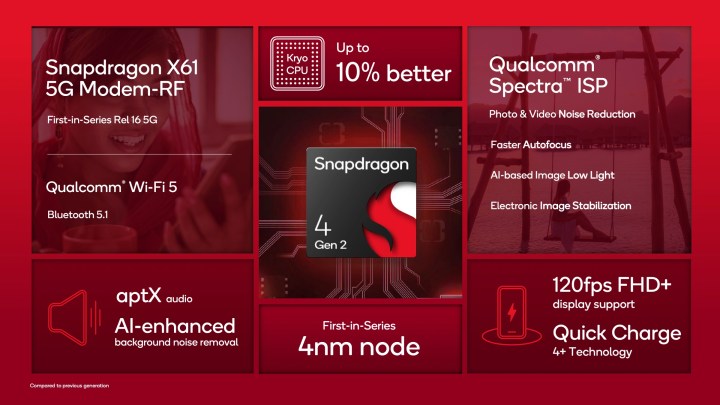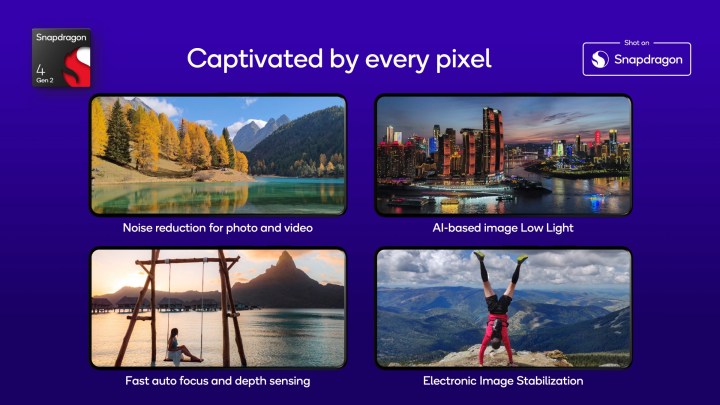
Qualcomm is upping the performance game with its new Snapdragon 4 Gen 2 mobile platform — a new chip that promises to deliver some of the best capabilities of the company’s higher-end platforms to a new generation of budget smartphones.
As one might expect, the Snapdragon 4 Gen 2 is the direct successor to last year’s Snapdragon 4 Gen 1, the first in the series to move to simpler branding when it replaced the 2021 Snapdragon 480+. Last year’s chip brought the usual year-over-year CPU and graphics performance gains while introducing a new image signal processor (ISP) that pushed its photographic capabilities to new heights.
What the Snapdragon 4 Gen 2 brings to the table

The Snapdragon 4 Gen 2 builds on its predecessor, closing the gap with pricier smartphones by delivering more of the capabilities previously reserved for those more expensive models — such as better 5G capabilities, faster display support, and computational photography improvements.
Although the Snapdragon 4 platform forms the lowest tier of Qualcomm’s system-on-chip (SoC) lineup, the company follows a “waterfalling” strategy of building features from the top down, scaling down features from its flagship Snapdragon 8 series to incorporate as many premium features as possible into its more affordable chips.
This year’s Snapdragon 4 Gen 2 is the first chip in its series to be built with a 4nm fabrication process, optimizing performance and power consumption over last year’s 6nm Gen 1 chip. That change alone opens up the possibility of significantly longer battery life for budget phones. However, it’s still up to the manufacturers to sharpen their pencils to deliver the best overall power efficiency.
Qualcomm is also moving to a new Snapdragon X61 5G Modem, the first-in-series to support the 3rd Generation Partnership Project (3GPP) Release 16 specification for 5G connectivity.
In practical terms, this means lower latency, better 5G connectivity, and reduced power consumption. In that regard, the new chip is roughly in line with the X65 modem used in Apple’s iPhone 14 lineup and Samsung’s Galaxy S22 series, although it doesn’t offer nearly the same peak performance. Like last year’s X51, the

Moving beyond 5G, the Snapdragon 4 Gen 2 provides a 10% performance boost over last year’s model, with the eight-core Kryo CPU now offering two performance cores that clock in at 2.2GHz, plus six efficiency cores at 2GHz. Dual-lane UFS 3.1 memory architecture will also improve data processing speeds.
The Spectra Image Signal Processor (ISP) has also undergone some changes, moving to a dual-ISP design compared to last year’s triple. This eliminates the possibility of capturing photos or videos concurrently from three cameras, although that was limited to 13MP stills and 720p videos in last year’s chip.
On paper, the Spectra ISP otherwise has the same specs introduced in the Gen 1 version, including 108-megapixel (MP) image capture and 1080p single video capture at 60 frames per second (fps) or 1080p dual video capture at 30 fps.
Nevertheless, Qualcomm says the new ISP delivers other enhancements that won’t show up in spec sheets — including improved photographic AI features that deliver better low-light performance, faster autofocus, electronic image stabilization, and significant noise reduction for photos and videos. The result should be much sharper pictures and clips, particularly when working with moving subjects or under less ideal lighting conditions.

Oddly, the Snapdragon 4 Gen 2 gets another minor spec drop, substituting last year’s Bluetooth 5.2 support for Bluetooth 5.1 in the second-generation chip. Support or aptX audio remains, courtesy of Qualcomm’s Aqstic audio codec. However, a new AI background noise removal feature will help ensure your voice can be heard more clearly when making calls in a busy place.
The Snapdragon 4 Gen 2 chip also continues to support Quick Charge 4+ Technology, allowing for a 50% recharge in just 15 minutes. It also remains ready to handle 120fps FHD+ displays. While not many budget smartphone makers are rushing out to incorporate pricier 120Hz panels into their phones, you can find a few from Redmi and Iqoo, the target customers for Qualcomm’s Snapdragon 4-series chips.
Qualcomm says we can expect the first Snapdragon 4 Gen 2 powered phones to hit the market in the second half of 2023, starting with “key OEM brands” Redmi and vivo.
Editors' Recommendations
- Qualcomm’s newest chip will supercharge budget Android phones
- This tiny dongle will change 5G connectivity forever
- The Snapdragon 8 Gen 3 is here, and it’s a big deal for Android phones
- Qualcomm’s new Snapdragon 7+ Gen 2 is big news for cheap phones
- Qualcomm’s Snapdragon X75 ushers in the next era of 5G connectivity




